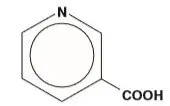Drug Detail:Niacor (Niacin (nicotinic acid) [ nye-a-sin ])
Drug Class: Miscellaneous antihyperlipidemic agents Vitamins
Related/similar drugs
Repatha, Leqvio, atorvastatin, rosuvastatin, simvastatin, Lipitor, ezetimibeIndications and Usage for Niacor
I. Therapy with lipid-altering agents should be only one component of multiple risk factor intervention in those individuals at significantly increased risk for atherosclerotic vascular disease due to hypercholesterolemia. Nicotinic acid, alone or in combination with a bile-acid binding resin, is indicated as an adjunct to diet for the reduction of elevated total and LDL cholesterol levels in patients with primary hypercholesterolemia (Types IIa and IIb)†, when the response to a diet restricted in saturated fat and cholesterol and other nonpharmacologic measures alone has been inadequate (see also the NCEP treatment guidelines6). Prior to initiating therapy with nicotinic acid, secondary causes for hypercholesterolemia (e.g., poorly controlled diabetes mellitus, hypothyroidism, nephrotic syndrome, dysproteinemias, obstructive liver disease, other drug therapy, alcoholism) should be excluded, and a lipid profile performed to measure total cholesterol, HDL cholesterol, and triglycerides.
II. Nicotinic acid is also indicated as adjunctive therapy for the treatment of adult patients with very high serum triglyceride levels (Types IV and V hyperlipidemia)† who present a risk of pancreatitis and who do not respond adequately to a determined dietary effort to control them. Such patients typically have serum triglyceride levels over 2,000 mg/dL and have elevations of VLDL cholesterol as well as fasting chylomicrons (Type V hyperlipidemia)†. Subjects who consistently have total serum or plasma triglycerides below 1,000 mg/dL are unlikely to develop pancreatitis. Therapy with nicotinic acid may be considered for those subjects with triglyceride elevations between 1,000 and 2,000 mg/dL who have a history of pancreatitis or of recurrent abdominal pain typical of pancreatitis. Some Type IV patients with triglycerides under 1,000 mg/dL may, through dietary or alcoholic indiscretion, convert to a Type V pattern with massive triglyceride elevations accompanying fasting chylomicronemia, but the influence of nicotinic acid therapy on the risk of pancreatitis in such situations has not been adequately studied. Drug therapy is not indicated for patients with Type I hyperlipoproteinemia, who have elevations of chylomicrons and plasma triglycerides, but who have normal levels of VLDL. Inspection of plasma refrigerated for 14 hours is helpful in distinguishing Types I, IV, and V hyperlipoproteinemia7.
| Lipoproteins | Lipid Elevations | |||
|---|---|---|---|---|
| Type | Elevated | Major | Minor | |
| C = cholesterol, TG = triglycerides | ||||
| LDL = low-density lipoprotein | ||||
| VLDL = very low-density lipoprotein | ||||
| IDL = intermediate-density lipoprotein | ||||
| I | (rare) | Chylomicrons | TG | ↑→ C |
| IIa | LDL | C | ..... | |
| IIb | LDL, VLDL | C | TG | |
| III | (rare) | IDL | C/TG | ..... |
| IV | VLDL | TG | ↑→ C | |
| V | (rare) | Chylomicrons, VLDL | TG | ↑→ C |
Warnings
Skeletal Muscle
Rare cases of rhabdomyolysis have been associated with concomitant administration of lipid-altering doses (≥1 g/day) of nicotinic acid and HMG-CoA reductase inhibitors. Physicians contemplating combined therapy with HMG-CoA reductase inhibitors and nicotinic acid should carefully weigh the potential benefits and risks and should carefully monitor patients for any signs and symptoms of muscle pain, tenderness, or weakness, particularly during the initial months of therapy and during any periods of upward dosage titration of either drug. Periodic serum creatine phosphokinase (CPK) and potassium determinations should be considered in such situations, but there is no assurance that such monitoring will prevent the occurrence of severe myopathy.
Adverse Reactions/Side Effects
Cardiovascular: Atrial fibrillation and other cardiac arrhythmias, orthostasis, hypotension.
Gastrointestinal: Dyspepsia, vomiting, diarrhea, peptic ulceration, jaundice, abnormal liver function tests.
Skin: Mild to severe cutaneous flushing, pruritus, hyperpigmentation, acanthosis nigricans, dry skin.
Metabolic: Decreased glucose tolerance, hyperuricemia, gout.
Eye: Toxic amblyopia, cystoid macular edema.
Nervous System / Psychiatric: Headache.
| NIACOR
niacin tablet |
||||||||||||||||||
|
||||||||||||||||||
|
||||||||||||||||||
|
||||||||||||||||||
|
||||||||||||||||||
|
||||||||||||||||||
|
||||||||||||||||||
| Labeler - Avondale Pharmaceuticals, LLC (080843532) |






